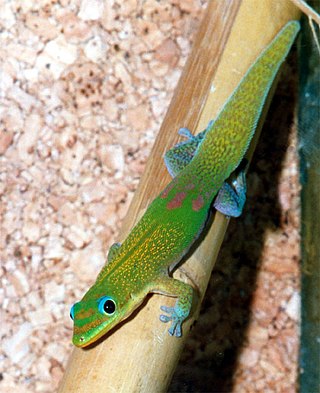
Geckos are small, mostly carnivorous lizards that have a wide distribution, found on every continent except Antarctica. Belonging to the infraorder Gekkota, geckos are found in warm climates throughout the world. They range from 1.6 to 60 centimetres.

Torosaurus is a genus of herbivorous chasmosaurine ceratopsian dinosaur that lived during the late Maastrichtian age of the Late Cretaceous period, between 68 and 66 million years ago, though it is possible that the species range might extend to as far back as 69 million years ago. Fossils have been discovered across the Western Interior of North America, from as far north as Saskatchewan to as far south as Texas.

Urticating hairs or urticating bristles are one of the primary defense mechanisms used by numerous plants, almost all New World tarantulas, and various lepidopteran caterpillars. Urtica is Latin for "nettle", and bristles that urticate are characteristic of this type of plant, and many other plants in several families. This term also refers to certain types of barbed bristles that cover the dorsal and posterior surface of a tarantula's or caterpillar's abdomen. Many tarantula species eject bristles from their abdomens, directing them toward potential attackers. These bristles can embed themselves in the other animal's skin or eyes, causing physical irritation, usually to great discomfort. The term urticating hairs is a misnomer, as technically only mammals possess true hairs.

Dermestidae are a family of Coleoptera that are commonly referred to as skin beetles. Other common names include larder beetle, hide or leather beetles, carpet beetles, and khapra beetles. There are over 1,800 species described.

A black fly or blackfly is any member of the family Simuliidae of the Culicomorpha infraorder. It is related to the Ceratopogonidae, Chironomidae, and Thaumaleidae. Over 2,200 species of black flies have been formally named, of which 15 are extinct. They are divided into two subfamilies: Parasimuliinae contains only one genus and four species; Simuliinae contains all the rest. Over 1,800 of the species belong to the genus Simulium.

Lumbriculus variegatus, also known as the blackworm or California blackworm, is a species of worm inhabiting North America and Europe. It lives in shallow-water marshes, ponds, and swamps, feeding on microorganisms and organic material. The maximum length of a specimen is 10 cm. Worms raised in laboratory environment are slightly shorter, with 4 to 6 cm long bodies. An adult individual has approximately 150 to 250 1.5 mm wide segments, each of which has the ability to regenerate into a new individual when separated from the rest of the animal. In most populations, this is the primary mode of reproduction, and mature individuals are exceedingly rare; in large areas mature individuals have never been found.
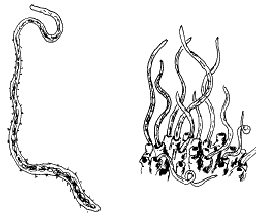
Tubifex is a cosmopolitan genus of tubificid annelids that inhabits the sediments of lakes, rivers and occasionally sewer lines. At least 13 species of Tubifex have been identified, with the exact number not certain, as the species are not easily distinguishable from each other.
Lumbriculus genitosetosus was described by Holmquist in 1976 from almost 2,000 individuals collected in Northern Alaska. Initially, Holmquist revived the genus Thinodrilus for L. genitosetosus, Lumbriculus inconstans and Lumbriculus ambiguus on the basis of the Lumbriculus-species having only one pair of vas deferens and sperm funnels per atrium, whereas the Thinodrilus-species have two ; this division is, however, not generally recognised today, even if Thinodrilus may be a valid subgenus.

The blacktip sawtail catshark is a species of catshark, and part of the family Scyliorhinidae, found off the coasts of Taiwan and the Philippines. It is demersal in nature and occurs deeper than 60 m (200 ft). Growing up to 46 cm (18 in) long, this slim-bodied species is characterized by its plain brownish dorsal coloration with dark tips on the dorsal and caudal fins, and a prominent crest of enlarged dermal denticles on the upper edge of the caudal fin. It is oviparous, with females producing encapsulated eggs two at a time year-round. The blacktip sawtail catshark is caught incidentally in bottom trawls and used for fishmeal in Taiwan.

Lumbriculus is a genus of oligochaete annelids.

The rock squirrel is a species of rodent in the family Sciuridae. It is native to Mexico and the Southwestern United States, including southern Nevada, Utah, Colorado, Arizona, New Mexico, West Texas, and the panhandle of Oklahoma.

Tarantulas comprise a group of large and often hairy spiders of the family Theraphosidae. As of August 2022, 1,040 species have been identified, with 156 genera. The term "tarantula" is usually used to describe members of the family Theraphosidae, although many other members of the same infraorder (Mygalomorphae) are commonly referred to as "tarantulas" or "false tarantulas". Some of the more common species have become popular in the exotic pet trade. Many New World species kept as pets have setae known as urticating hairs that can cause irritation to the skin, and in extreme cases, cause damage to the eyes.
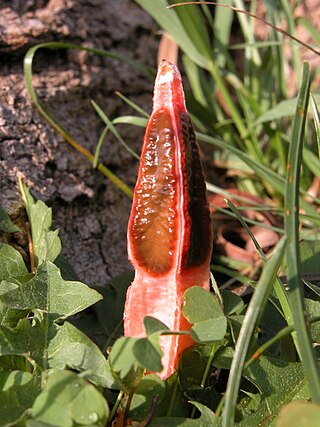
Lysurus mokusin, commonly known as the lantern stinkhorn, the small lizard's claw, or the ribbed lizard claw, is a saprobic species of fungus in the family Phallaceae. The fruit body consists of a reddish, cylindrical fluted stipe that is capped with several "arms". The arms can approach or even close in on each other to form a spire. The gleba—an olive-green slimy spore mass—is carried on the outer surface of the arms. The fruit body, which has an odor comparable to "fresh dog feces", "rotting flesh", or "sewage" when mature, is edible in its immature "egg" stage. The fungus is native to Asia, and is also found in Australia, Europe and North America, where it is probably an introduced species. It has been used medicinally in China as an ulcer remedy.

Parasola auricoma is a species of agaric fungus in the family Psathyrellaceae. First described scientifically in 1886, the species is found in Europe, Japan, and North America. The mushroom was reported in February 2019 in Colombia, in the city of Bogota by the mycologist Juan Camilo Rodriguez Martinez. The small, umbrella-shaped fruit bodies (mushrooms) of the fungus grow in grass or woodchips and are short-lived, usually collapsing with age in a few hours. The caps are up to 6 cm (2.4 in) wide, initially elliptical before flattening out, and colored reddish-brown to greyish, depending on their age and hydration. They are pleated with radial grooves extending from the center to the edge of the cap. The slender, whitish stems are up to 12 cm (4.7 in) long and a few millimeters thick. Microscopically, P. auricoma is characterized by the presence of setae in its cap cuticle. This characteristic, in addition to the relatively large, ellipsoid spores can be used to distinguish it from other morphologically similar Parasola species.

Dactylopius is a genus of insect in the superfamily Coccoidea, the scale insects. It is the only genus in the family Dactylopiidae. These insects are known commonly as cochineals, a name that also specifically refers to the best-known species, the cochineal. The cochineal is an insect of economic and historical importance as a main source of the red dye carmine. It has reportedly been used for this purpose in the Americas since the 10th century. Genus Dactylopius is also important because several species have been used as agents of biological pest control, and because several are known as invasive species.

Zigrasimecia is an extinct genus of ants which existed in the Cretaceous period approximately 98 million years ago. The first specimens were collected from Burmese amber in Kachin State, 100 kilometres (62 mi) west of Myitkyina town in Myanmar. In 2013, palaeoentomologists Phillip Barden and David Grimaldi published a paper describing and naming Zigrasimecia tonsora. They described a dealate female with unusual features, notably the highly specialized mandibles. Other features include large ocelli, short scapes, 12 antennomeres, small eyes, and a clypeal margin that has a row of peg-like denticles. The genus Zigrasimecia was originally incertae sedis within Formicidae until a second species, Zigrasimecia ferox, was described in 2014, leading to its placement in the subfamily Sphecomyrminae. Later, it was considered to belong to the distinct subfamily Zigrasimeciinae.
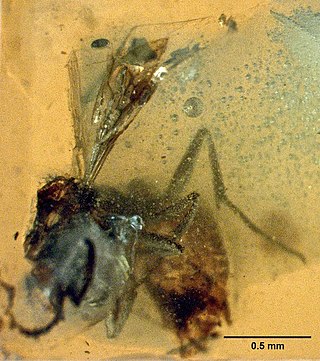
Haidomyrmodes is an extinct genus of ant in the formicid subfamily Haidomyrmecinae, and is one of only nine genera placed in the subfamily Haidomyrmecinae. The genus contains a single described species, Haidomyrmodes mammuthus. Haidomyrmodes is known from several Middle Cretaceous fossils which have been found in Europe.

Echinophthiriidae is a family of lice in the suborder Anoplura, the sucking lice. This family of lice are parasites of seals and the river otter, and are the only insects that infest aquatic hosts.
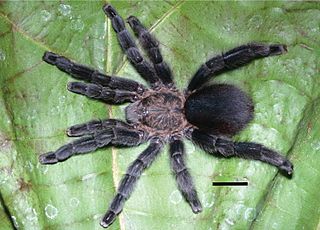
Pachistopelma bromelicola is a species of tarantula, contained within the Aviculariinae subfamily. It is endemic to Brazil.
Polytrichum hyperboreum is a species of moss belonging to the genus Polytrichum, commonly found throughout arctic regions of the world. Members of this dioecious species readily produces sporophytes with their sporophytic structure, consisting of a foot, seta, capsule, and a hairy calyptra, similar to other Polytrichum species. Polytrichum hyperboreum is distinguishable by certain unique features of there gametophytic structure that sets them apart from other genus members.
















